settings
children
With Famly since
1. A rhyming basket

The rhyming game
Forget the spelling, this example of rhyming games EYFS is completely auditory. You just need to identify similar-sounding words by pairing the objects in the basket with similar sounds.
What you need
- A basket.
- Toys and objects that have a rhyming partner — like a goat and a boat, a fox and a box, or a cat and a hat.
How to do it
First, allow the child to pick an object from the basket and name it. Now, you can look through all of the other objects in the basket, together, to identify its rhyming pair. Encourage the child to run through the names out loud. You might need to repeat the name of the first object every now and again to keep reminding the child of the rhyming sound they’re trying to make.
Image credit: Imagination tree
2. Act out rhyming action words

The rhyming game
Movement accompanying a phrase helps you to memorise it better. Rhyming games EYFS like this one, combine the task of forming rhyming sounds verbally while gesturing.
What you need
- A few sentences that contain two rhyming words. The one at the end needs to be an action word (jump, run, sit, skip or swim, to name a few ideas).
- Sentences you could use include: “Bump rhymes with JUMP!” and “Keep rhymes with LEAP!”
How to do it
Read the sentence out loud, encourage the children to repeat it, and after they’ve said it, they need to act out the last word – like LEAP, or “JUMP”. Repeating the sentence helps them to remember what rhyming means and the little action at the end will keep them thrilled with this educational rhyming game.
Idea credit: Learning at the primary pond
3. Play “find your rhyming partner”
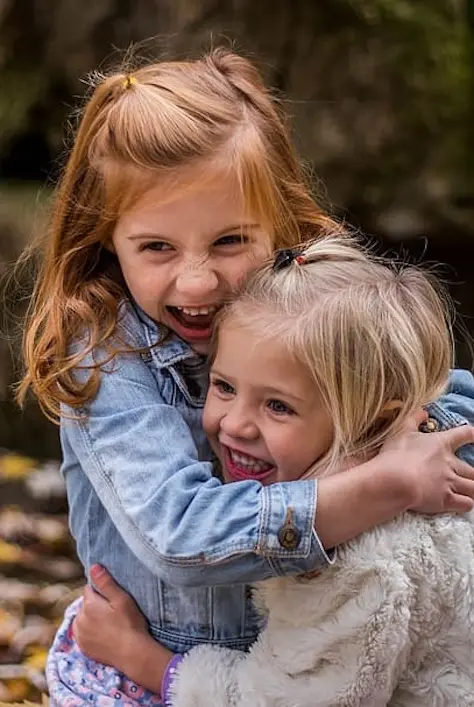
The rhyming game
It’s sort of like a scavenger hunt, except that the children have to solve a rhyming riddle to find their friend.
What you need
- Simple labels or stickers that can attach to children’s clothing easily.
- Each label/sticker needs an image on it that rhymes with the image on another one — like a cat and a hat, or a fish and a dish.
How to do it
Each child has a sticker or label. The children have to understand the label they’re wearing and know exactly what the sound is they’re looking for. Now, they can look through the crowd of classmates they have to find a picture that rhymes with the picture they’re wearing. You may need to help them by repeating their word often, so that they can remember the sound and find its match when they hear someone else’s sound. Encourage the children to verbalise their own sounds as much as possible.
Idea credit: Learning at the primary pond
4. Rhyming bingo
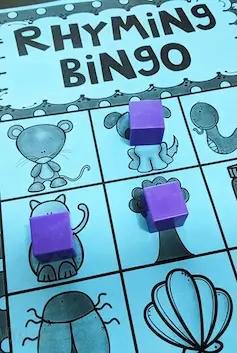
The rhyming game
By adding a rhyming element to bingo, children get to hone their linguistics abilities by learning to listen for certain vowels and their sounds.
What you need
- A bingo game set.
- A board displaying images of things that rhyme with each other.
How to do it
Use items like beans or pennies for markers. The students have to use the markers to identify rhyming words – encourage them to say each word out loud and listen out for a rhyming sound.
Image credit: Teachers pay teachers
5. Sort by rhyme
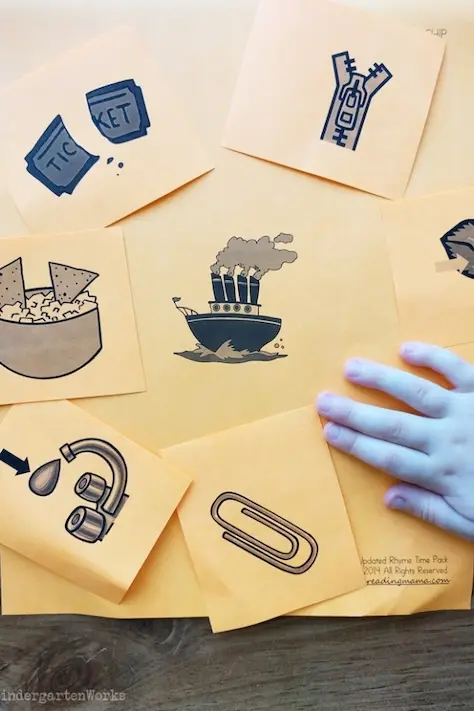
The rhyming game
A mix and match game of identifying rhyming cards and matching them with the correct mat.
What you need
- A few larger pieces of paper with a printed image in the centre.
- Smaller paper cut-outs paper to serve as playing cards.
- Ensure that each mat has a collection of cards containing images that rhyme with the mat’s image.
How to do it
Use the larger image as a “mat”. Have the children repeat the word on the mat — in the case of the image, it’s “boat”. Now, using the smaller cut-outs (called cards), have the children verbalise the name of each image on the cards and identify the words that rhyme with the image on the mat. When they find a word that rhymes with the one on the mat, they can place it on the mat until a full rhyming family consisting of a mat that is surrounded by cards, is completed.
Image credit: This reading mama
6. Whack-a-rhyme
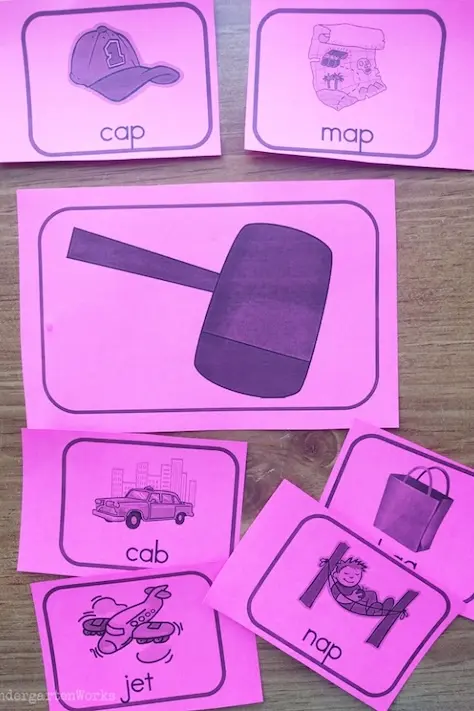
The rhyming game
Slamming hands, winning cards, and rhyming words: all the makings of a tremendously fun learning game.
What you need
- Printed pictures with rhyming matches.
- A printed picture of a mallet, a bit larger than the other pictures.
How to do it
The mallet card serves as the place to slam fists (or palms) down, which children do whenever they identify a rhyming match. First, start by placing a card next to the mallet. Slowly, turn over other cards. When the children identify another picture that rhymes with the first one, they can slam the mallet. The first one to recognise the rhyme wins, and collects the pair of cards. You can play until one player collects a certain number of cards.
Image credit: Kindergarten works
7. Memory game (the rhyming edition)

The rhyming game
Do the words rhyme? This interactive game will help boost children’s memory and enable them to build awareness of vowels and their sounds.
What you need
- Cards – normal memory game cards work well, handmade or printed cards work too. Ensure there are two of each card, if you’re making them by hand.
How to do it
Lay out all of the cards. Each child can have a turn to turn over two cards in the hopes that they are a matching pair. Add the rhyming element to this game by helping children to sound out the words of the cards they’ve turned over and decide whether or not they rhyme. You could make rhyming part of the goal or you can just make it a fun extra element in the game.
Idea credit: Fun-a-day
8. The “rhyming room” game
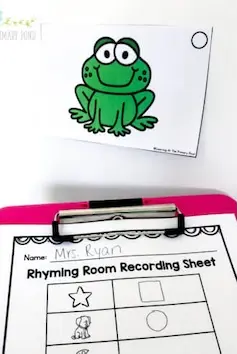
The rhyming game
The rhyming room enables some independent discovery, as children hunt around the room to find their rhyming match.
What you need
- Printed (or hand-drawn) images, each on a separate piece of paper. Ensure each image has a “match” that rhymes – like a cat and bat.
How to do it
Your preparation starts before the children arrive. Place your printed paper images all around the classroom. Then, give each child a piece of paper with an image on it that matches one of the printouts you’ve placed somewhere in the classroom. Help each child to verbalise the word on their piece of paper so that they can look for the image that will rhyme with their very own word.
Image credit: Learning at the primary pond
9. Walk the tightrope
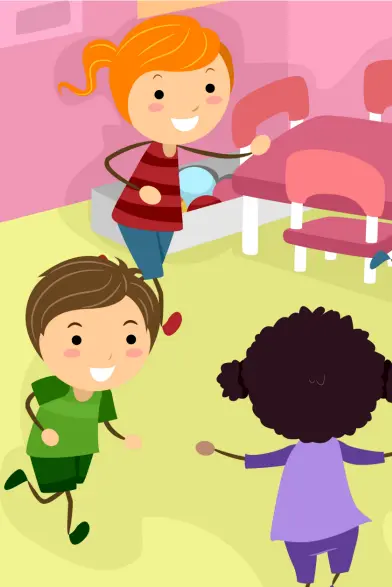
The rhyming game
Develop gross motor skills, have fun trying to balance, and learn about rhyming all at the same time.
What you need
- A rope.
- Pictures with rhyming pairs.
- Footprint cut-outs.
How to do it
The rope is just for fun, lay it out on the ground and place the footprint cut-outs to represent footsteps on either side of the rope. Place the pictures in the footprint cut-outs, ensuring the rhyming words come after each other. The children have to use the footprint cutouts as stepping stones, saying the word of the picture they’re about to stand on. Help them to identify the similar-sounding words as rhyming words.
Image credit: Fun-a-day
10. The rhyme challenge
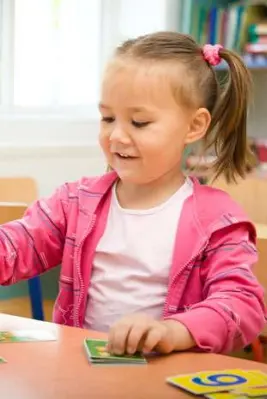
The rhyming game
Like I-spy, this game is a great way to pass time. You can do it anywhere, just using your imagination and observational skills.
What you need
- You don’t need anything but sharp rhyming skills and an ear for vowels.
How to do it
Use the phrase “I challenge you to think of as many rhymes as you can for ‘cat’ (or insert the word of your choice)”. Allow the children to bombard you with words that rhyme with your chosen word. If they battle, give them clues – if they haven’t played rhyming games before this one might be tricky. It’s a great classroom game to bring children’s attention to you. It’s also educational, training the children’s ears to identify rhyming sounds and build an awareness of words and how they’re pronounced.
Image credit: Scholastic
The big ideas
Please note: here at Famly we love sharing creative activities for you to try with the children at your setting, but you know them best. Take the time to consider adaptions you might need to make so these activities are accessible and developmentally appropriate for the children you work with. Just as you ordinarily would, conduct risk assessments for your children and your setting before undertaking new activities, and ensure you and your staff are following your own health and safety guidelines.
Get 1000s of free EY activities
Want over 7,000 activities? See them in a free 14-day trial. Filter to target learning areas, age groups and topics, and get inspired.
Get started









